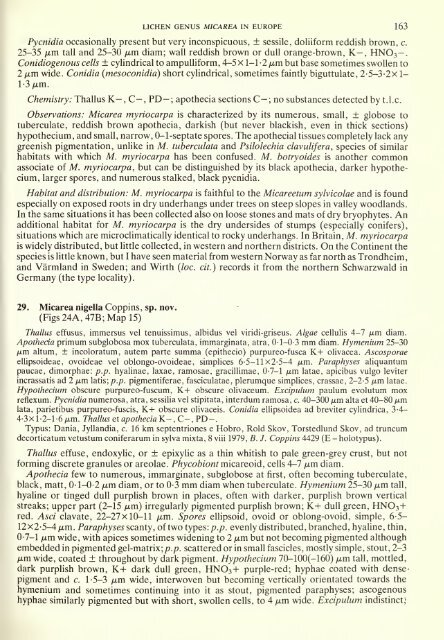Bulletin of the British Museum (Natural History)
Bulletin of the British Museum (Natural History)
Bulletin of the British Museum (Natural History)
Create successful ePaper yourself
Turn your PDF publications into a flip-book with our unique Google optimized e-Paper software.
LICHEN GENUS MICAREA IN EUROPE 163<br />
Pycnidia occasionally present but very inconspicuous, ± sessile, doliiform reddish brown, c.<br />
25-35 ixm tall and 25-30 /xm diam; wall reddish brown or dull orange-brown, K— , HNO3—<br />
Conidiogenous cells ± cylindrical to ampulliform, 4-5 x 1-1 -2 /xm but base sometimes swollen to<br />
2 jxm wide. Conidia (mesoconidia) short cylindrical, sometimes faintly biguttulate, 2-5-3-2xl-<br />
1-3 fxm.<br />
Chemistry: Thallus K— , C— , PD— ; apo<strong>the</strong>cia sections C— ; no substances detected by t.l.c.<br />
Observations: Micarea myriocarpa is characterized by its numerous, small, ± globose to<br />
tuberculate, reddish brown apo<strong>the</strong>cia, darkish (but never blackish, even in thick sections)<br />
hypo<strong>the</strong>cium, and small, narrow, 0-1-septate spores. The apo<strong>the</strong>cial tissues completely lack any<br />
greenish pigmentation, unlike in M. tuberculata and Psilolechia clavulifera, species <strong>of</strong> similar<br />
habitats with which M. myriocarpa has been confused. M. botryoides is ano<strong>the</strong>r common<br />
associate <strong>of</strong> M. myriocarpa, but can be distinguished by its black apo<strong>the</strong>cia, darker hypo<strong>the</strong>cium,<br />
larger spores, and numerous stalked, black pycnidia.<br />
Habitat and distribution: M. myriocarpa is faithful to <strong>the</strong> Micareetum sylvicolae and is found<br />
especially on exposed roots in dry underhangs under trees on steep slopes in valley woodlands.<br />
In <strong>the</strong> same situations it has been collected also on loose stones and mats <strong>of</strong> dry bryophytes. An<br />
additional habitat for M. myriocarpa is <strong>the</strong> dry undersides <strong>of</strong> stumps (especially conifers),<br />
situations which are microclimatically identical to rocky underhangs. In Britain, M. myriocarpa<br />
is widely distributed, but little collected, in western and nor<strong>the</strong>rn districts. On <strong>the</strong> Continent <strong>the</strong><br />
species is little known, but I have seen material from western Norway as far north as Trondheim,<br />
and Varmland in Sweden; and Wirth {loc. cit.) records it from <strong>the</strong> nor<strong>the</strong>rn Schwarzwald in<br />
Germany (<strong>the</strong> type locality).<br />
29. Micarea nigella Coppins, sp. nov.<br />
(Figs24A,47B;Mapl5)<br />
Thallus effusus, immersus vel tenuissimus, albidus vel viridi-griseus. Algae cellulis 4-7 /xm diam.<br />
Apo<strong>the</strong>cia primum subglobosa mox tuberculata, immarginata, atra, 0- 1-0-3 mm diam. Hymenium 25-30<br />
/Ltm altum, ± incoloratum, autem parte summa (epi<strong>the</strong>cio) purpureo-fusca K-l- olivacea. Ascosporae<br />
ellipsoideae, ovoideae vel oblongo-ovoideae, simplices 6-5-11 x2-5-4 /xm. Paraphyses aliquantum<br />
paucae, dimorphae: p.p. hyalinae, laxae, ramosae, gracillimae, 0-7-1 /u,m latae, apicibus vulgo leviter<br />
incrassatis ad 2 /xm latis; p.p. pigmentiferae, fasciculatae, plerumque simplices, crassae, 2-2-5 ^tm latae.<br />
Hypo<strong>the</strong>cium obscure purpureo-fuscum, K+ obscure olivaceum. Excipulum paulum evolutum mox<br />
reflexum. Pycnidia numerosa, atra, sessilia vel stipitata, interdum ramosa, c. 40-300 )u,m alta et 40-80 /xm<br />
lata, parietibus purpureo-fuscis, K-l- obscure olivaceis. Conidia ellipsoidea ad breviter cylindrica, 3-4-<br />
4-3x1-2-1-6 ixm. Thallus et apo<strong>the</strong>cia K-, C-, PD-.<br />
Typus: Dania, Jyllandia, c. 16 km septentriones e Hobro, Rold Skov, Torstedlund Skov, ad truncum<br />
decorticatum vetustum coniferarum in sylva mixta, 8 viii 1979, B. J. Coppins 4429 (E - holotypus).<br />
Thallus effuse, endoxylic, or ± epixyhc as a thin whitish to pale green-grey crust, but not<br />
forming discrete granules or areolae. Phycobiont micareoid, cells 4-7 pm diam.<br />
Apo<strong>the</strong>cia few to numerous, immarginate, subglobose at first, <strong>of</strong>ten becoming tuberculate,<br />
black, matt, 0-1-0-2 pm diam, or to 0-3 mm diam when tuberculate. Hymenium 25-30 ^im tall,<br />
hyaline or tinged dull purplish brown in places, <strong>of</strong>ten with darker, purplish brown vertical<br />
streaks; upper part (2-15 pm) irregularly pigmented purplish brown; K-h dull green, HNO3-Ired.<br />
Asci clavate, 22-27x10-11 pm. Spores ellipsoid, ovoid or oblong-ovoid, simple, 6-5-<br />
12x2-5-4 /xm. Paraphyses scanty, <strong>of</strong> two types: p.p. evenly distributed, branched, hyaUne, thin,<br />
0-7-1 pm wide, with apices sometimes widening to 2 ^tm but not becoming pigmented although<br />
embedded in pigmented gel-matrix; p.p. scattered or in small fascicles, mostly simple, stout, 2-3<br />
pm wide, coated ± throughout by dark pigment. Hypo<strong>the</strong>cium 70-100(-160) pm tall, mottled,<br />
dark purplish brown, K-l- dark dull green, HNO3-I- purple-red; hyphae coated with densepigment<br />
and c. 1-5-3 pm wide, interwoven but becoming vertically orientated towards <strong>the</strong><br />
hymenium and sometimes continuing into it as stout, pigmented paraphyses; ascogenous<br />
hyphae similarly pigmented but with short, swollen cells, to 4 pm wide. Excipulum indistinct-<br />
.

















